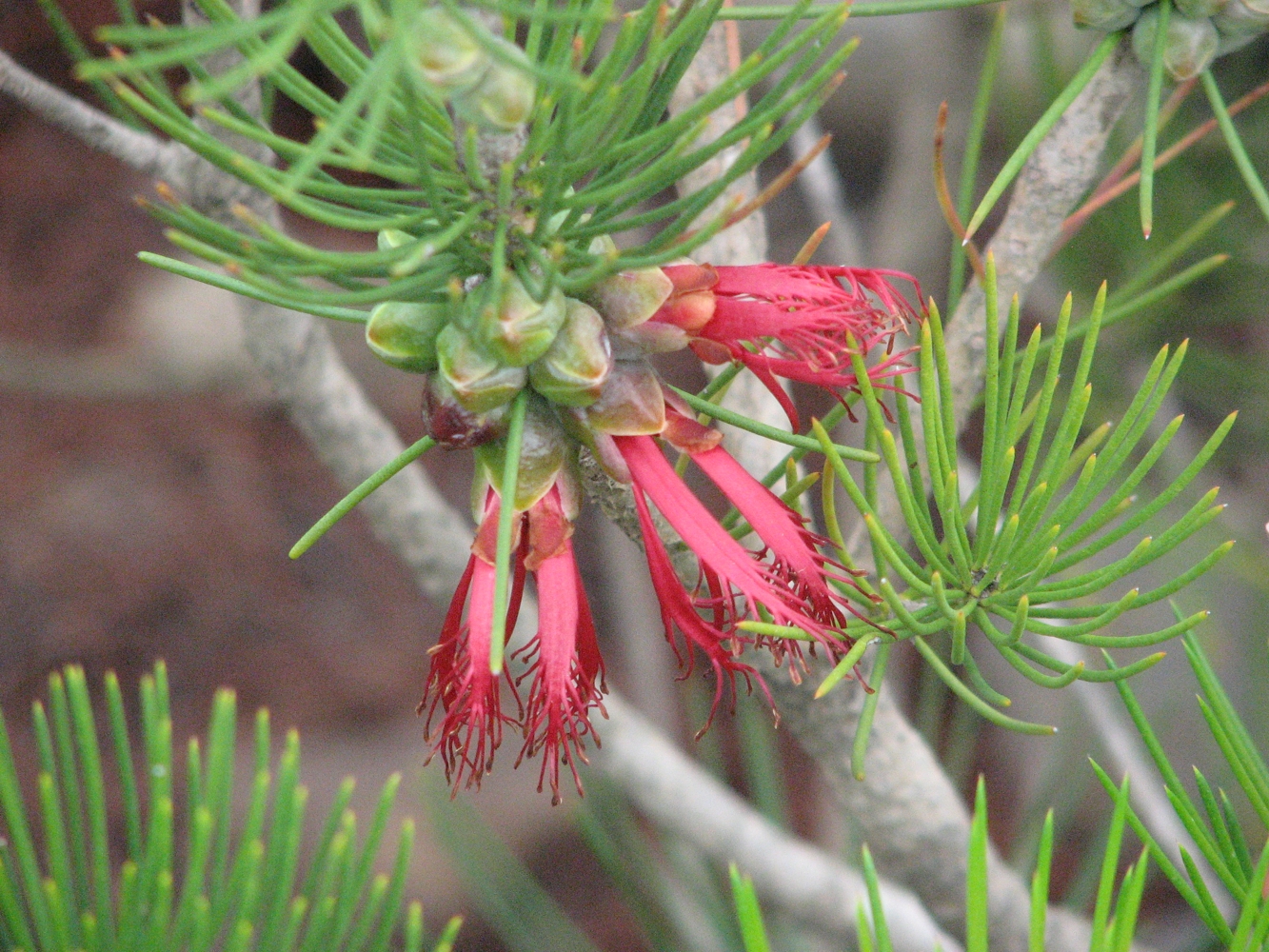Calothamnus Gracilis on:
[Wikipedia]
[Google]
[Amazon]
''Calothamnus'' is a genus of flowering plants in the family Myrtaceae and is endemic (ecology), endemic to the Southwest Australia, south-west of Western Australia. The common names one-sided bottlebrush or claw flower are given to some species due to their having the flowers clustered on one side of the stem or because of the claw-like appearance of their flowers. ''Calothamnus'' species are generally medium to tall woody shrubs with crowded leaves. In most species the leaves are crowded and linear in shape, and the flowers are usually arranged in dense clusters. The petals are small and fall off the flower soon after it opens but the stamens are long, numerous and usually bright red.


Description
Plants in the genus ''Calothamnus'' are medium to tall shrubs, sometimes low-growing ground covers. The leaves are linear or narrow lance-shaped with the narrower end towards the base, usually wikt:glabrous, glabrous and have distinct oil glands. The flowers are in small groups or dense spikes on leafless, older stems or between the leaves on younger ones. The sepals are fused to form a bell-shaped cup which is often immersed in the branch and there are four or five petals which usually fall off after the flower has opened. There are many stamens, joined for a large proportion of their length into four or five "claws". In some species the upper two claws are fused together and the lower ones are shorter. The stamens are brightly coloured, crimson to a deep purple or rarely yellow. The fruit is a woody Capsule (botany), capsule.

Taxonomy and naming
The first species in the genus to be described was ''Calothamnus sanguineus''. It was first formally described in 1806 by the French people, French biologist Jacques Labillardière in ''Novae Hollandiae Plantarum Specimen, Volume 2''. The name ''Calothamnus'' is derived from the Ancient Greek, Greek words ''kalos'' meaning "beautiful" and ''thamnos'' meaning "a shrub" or "a bush". In 2014, Lyndley Craven and others proposed, mainly on the basis of DNA evidence, that species in the genus ''Calothamnus'', along with those in ''Beaufortia (plant), Beaufortia'', ''Conothamnus'', ''Eremaea (plant), Eremaea'', ''Lamarchea'', ''Petraeomyrtus'', ''Phymatocarpus'' and ''Regelia'' be transferred to ''Melaleuca''.Distribution and habitat
All ''Calothamnus'' species are found in the Southwest Australia, south west botanical province of Western Australia. Some (such as ''Calothamnus aridus'') are adapted to a dry environment whilst others (such as ''Calothamnus hirsutus'') are often found near swamps.Use in horticulture
Most species of ''Calothamnus'' have been grown in gardens but need full sun and good drainage. Propagation is usually from seeds which are retained in the hard fruits throughout the life of the plant but cuttings can be used to retain the colour of yellow forms.Species list
The following is a list of species accepted by the Australian Plant Census as at June 2025: *''Calothamnus accedens'' Hawkeswood *''Calothamnus affinis'' Turcz. *''Calothamnus arcuatus'' Alex George (botanist), A.S.George *''Calothamnus aridus'' Hawkeswood *''Calothamnus blepharospermus'' F.Muell. *''Calothamnus borealis'' Hawkeswood *''Calothamnus brevifolius'' Hawkeswood *''Calothamnus chrysanthereus'' F.Muell. - claw flower *''Calothamnus cupularis'' A.S.George *''Calothamnus formosus'' Hawkeswood *''Calothamnus gibbosus'' Benth. *''Calothamnus gilesii'' F.Muell. *''Calothamnus glaber'' (Benth.) A.S.George *''Calothamnus gracilis'' R.Br. *''Calothamnus graniticus'' Hawkeswood *''Calothamnus hirsutus'' Hawkeswood *''Calothamnus huegelii'' Johannes Conrad Schauer, Schauer *''Calothamnus lateralis'' Lindl. *''Calothamnus lehmannii'' Schauer *''Calothamnus longissimus'' F.Muell. *''Calothamnus macrocarpus'' Hawkeswood *''Calothamnus microcarpus'' F.Muell. *''Calothamnus montanus'' A.S.George *''Calothamnus oldfieldii'' F.Muell. *''Calothamnus pachystachyus'' Benth. *''Calothamnus phellosus'' A.S.George *''Calothamnus pinifolius'' F.Muell. - dense claw-flower *''Calothamnus planifolius'' Lehm. *''Calothamnus preissii'' Schauer *''Calothamnus quadrifidus'' R.Br. - one-sided bottlebrush *''Calothamnus robustus'' Schauer *''Calothamnus roseus'' A.S.George *''Calothamnus rupestris'' Schauer - mouse ears *''Calothamnus sanguineus'' Labill. - silky-leaved blood-flower *''Calothamnus scabridus'' A.S.George *''Calothamnus schaueri'' Lehm. *''Calothamnus superbus'' Hawkeswood & Mollemans *''Calothamnus torulosus'' Schauer *''Calothamnus tuberosus'' Hawkeswood *''Calothamnus validus'' S.Moore - Barrens claw-flower *''Calothamnus villosus'' R.Br.References
{{Taxonbar, from=Q2713870 Calothamnus, Myrtaceae genera Myrtales of Australia Rosids of Western Australia Taxa named by Jacques Labillardière Endemic flora of Southwest Australia